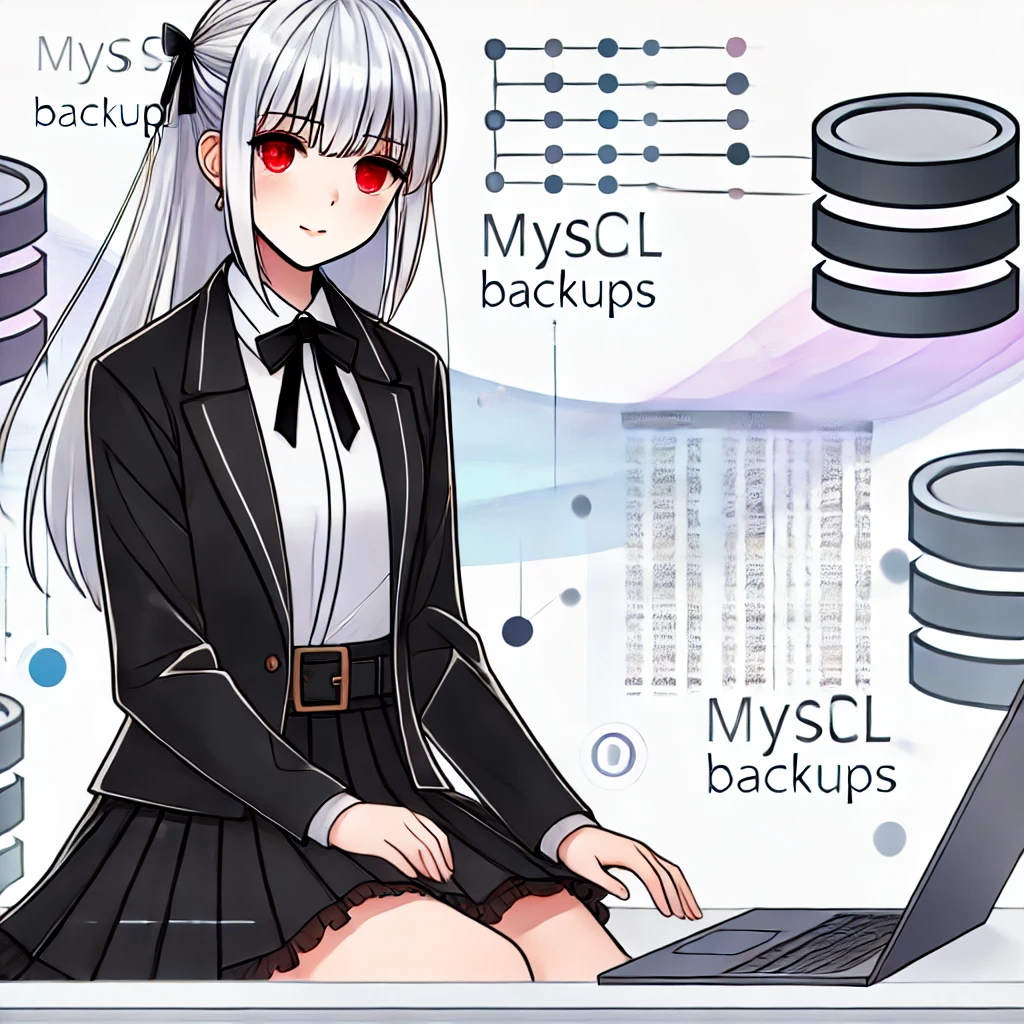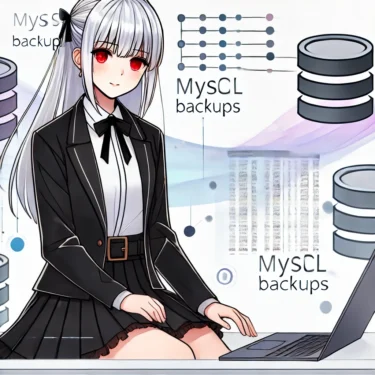目次
- 1 1. The Importance of MySQL Backups
- 2 2. MySQL Backup Basics
- 3 3. How to Back Up MySQL
- 4 4. Backup Best Practices
- 5 5. Restore (Recovery) Procedure
- 6 6. FAQ Section
- 6.1 Q1: What happens if the database is modified while a backup is being taken?
- 6.2 Q2: Backing up a large database with mysqldump takes too long. What can be done?
- 6.3 Q3: The backup file is too large. How can I compress it?
- 6.4 Q4: Can I restore only specific data from a backup file?
- 6.5 Q5: What should I check if a backup fails?
- 6.6 Q6: I don’t want to include the password in the backup script. What can I do?
- 6.7 Q7: How can I store backups in cloud storage?
- 7 7. Summary
1. The Importance of MySQL Backups
Databases are a critical component that manage the core information for many websites and applications. MySQL, in particular, is a widely used open‑source database management system employed by numerous businesses and personal projects. However, data can be lost for various reasons, and without backups you can end up in an irrecoverable situation.Risks of Data Loss
The main causes of data loss include:- Hardware Failure The server’s hard drive or SSD can suddenly fail, making the data inaccessible.
- Human Error Data may be accidentally deleted or the entire database overwritten due to mishandling.
- Cyber Attacks Ransomware or hacking can lead to data theft or encryption.
- Software Bugs Updates or configuration changes can cause database corruption.
Benefits of Backups
Implementing backups provides the following benefits:- Data Recovery Even if data is lost, a backup allows for rapid restoration, minimizing business downtime.
- Increased Peace of Mind Preparing for unexpected issues reduces operational stress.
- Compliance Many industries require data protection obligations. Regular backups help meet these requirements.
The Importance of Regular Backups
The frequency of backups depends on system usage and data importance. For example, e‑commerce sites or financial institutions that update data in real time should back up daily or even hourly. In contrast, a personal blog may only need a weekly backup. When creating a backup plan, it’s essential to specify the frequency, method, and storage location.
2. MySQL Backup Basics
MySQL backups can be performed effectively by first understanding the basic concepts. This section provides a detailed explanation of backup types and methods.Backup Types
MySQL backups can be broadly categorized into the following three types. Understanding the characteristics of each and selecting the method best suited to your system is important.- Full Backup A full backup copies the entire database. It is the simplest and most reliable method, but for large data volumes it consumes a lot of time and storage. Features:
- Backup process is simple and reliable.
- Restore procedures are straightforward.
- High load when data volume is large. Use Cases:
- Weekly scheduled backup.
- When performing a backup for the first time.
- Incremental Backup An incremental backup saves only the data changed since the previous backup. It saves storage and time, but restoration requires multiple backup files. Features:
- Low storage consumption.
- Fast backup speed.
- Restoration can be complex. Use Cases:
- Short backups run daily.
- Differential Backup A differential backup stores data changed since the initial full backup. It results in fewer files than incremental backups, making restoration easier, but it uses more storage compared to incremental backups. Features:
- Restoration is simpler than incremental.
- Efficient when combined with a full backup.
- Higher storage consumption than incremental. Use Cases:
- When critical data is updated frequently.
Backup Method Categories
In MySQL, backup methods are also divided into the following two types. Understanding the advantages and disadvantages of each helps you choose the method best suited to your system.- Physical Backup Physical backup copies the data files and log files themselves. It offers fast backup speed and is suitable for large-scale databases. Advantages:
- Fast backup and restore possible.
- Suitable for large-capacity databases.
- High reliability because it operates at the file system level. Disadvantages:
- Difficult to restore only specific data or tables.
- Some methods may encounter issues while the database is running. Applicable Tool Examples:
- Percona XtraBackup
- File system copy (tar, rsync)
- Logical Backup Logical backup exports data in SQL format. It is convenient for small databases or when you want to back up individual tables or data. Advantages:
- Can back up only specific data or tables.
- Migration is easy even if database versions differ. Disadvantages:
- Backup and restore take time.
- Inefficient for large data volumes. Applicable Tool Examples:
- mysqldump
- MySQL Workbench
Which Method Should You Choose?
Choosing a backup method depends on the database size, update frequency, and operational setup. Consider the optimal approach for each situation as follows.- Small sites or personal projects:
- Perform regular logical backups (mysqldump).
- Mid-size and larger systems:
- Combine full backups with incremental backups.
- Use physical backups for efficiency.
- Systems where real-time performance is critical:
- Adopt physical backups to speed up restores.
- Consider automated backups in cloud environments.

3. How to Back Up MySQL
There are several specific methods for backing up MySQL. This section provides detailed explanations of each method, including actual commands and procedures. We focus on the representative techniques: mysqldump command, physical backup, and automatic backup configuration.Backup Using the mysqldump Command
mysqldump is one of the most commonly used backup tools for MySQL. It exports data in SQL format, making it convenient for migrating to other databases or restoring. Basic Usage- Backup the Entire Database
mysqldump -u [username] -p[password] [database_name] > [destination_file.sql][username]: MySQL user name.[password]: MySQL password (do not put a space between-pand the password).[database_name]: Name of the database you want to back up.[destination_file.sql]: Path to the SQL file to be saved.
- Backup Multiple Databases
mysqldump -u [username] -p[password] --databases [database_name1] [database_name2] > [destination_file.sql]- Backup All Databases
mysqldump -u [username] -p[password] --all-databases > [destination_file.sql]--single-transaction: Back up while maintaining consistency of transactional databases.--routines: Also back up stored procedures and functions.--no-data: Back up only the table structure (no data).
- For large databases, mysqldump may take a long time to run. In such cases, consider physical backups or other tools.
How to Perform a Physical Backup
Physical backup copies MySQL data files directly for restoration. This method is suitable for large databases or when fast recovery is needed. Basic Steps- Copy the Data Directory
- Stop the MySQL server.
bash systemctl stop mysql - Copy the data directory (usually
/var/lib/mysql).bash cp -R /var/lib/mysql /backup_destination/ - Restart the server.
bash systemctl start mysql
- Backup Using Percona XtraBackup
- Percona XtraBackup is a tool that can back up MySQL data while it is running.
bash xtrabackup --backup --target-dir=/backup_destination/ - The created backup is stored in a restorable format.
- Pros:
- Backup speed is fast.
- Can efficiently store large amounts of data.
- Cons:
- Consumes a lot of disk space.
- Difficult to back up only specific tables or data.
Setting Up Automatic Backups
Automation is essential for performing regular backups. This section introduces how to set up a backup script using Linux cron jobs. Script Example Below is an example of an automatic backup script using mysqldump:#!/bin/bash
# Backup destination directory
BACKUP_DIR="/path/to/backup/"
# Backup file name with date
FILE_NAME="backup_$(date +'%Y%m%d_%H%M%S').sql"
# MySQL connection information
USER="root"
PASSWORD="yourpassword"
DATABASE="yourdatabase"
# Execute backup
mysqldump -u $USER -p$PASSWORD $DATABASE > $BACKUP_DIR$FILE_NAME
# Delete old backup files (older than 30 days)
find $BACKUP_DIR -type f -mtime +30 -exec rm {} ;
echo "Backup completed: $FILE_NAME"- Grant execution permission to the script:
chmod +x /path/to/backup_script.sh- Register with cron (e.g., run daily at 2 AM):
crontab -e 0 2 * * * /path/to/backup_script.sh- Adding a setting to transfer backup files to external storage or the cloud improves security.
- You can also use MySQL’s
~/.my.cnffile to avoid storing passwords in plain text within the script.

4. Backup Best Practices
To back up MySQL properly, it’s important to understand best practices for efficient and secure operation, not just saving data. This section introduces recommendations for effective backup management.Choosing and Managing Storage Locations
Carefully selecting where to store backup files can significantly reduce the risk of data loss.- Leverage External Storage
- By storing backup files not only on local disks but also on external storage or cloud services, you can prevent loss due to hardware failure or disasters.
- Recommended services:
- Amazon S3
- Google Cloud Storage
- Microsoft Azure
- Implement Generational Management (Versioning)
- Keeping multiple generations of backups allows you to restore to a specific point in time when needed.
- Example: retain the three most recent backups and delete older ones.
- Enhance Security with Encryption
- If the data is highly confidential, encrypting backup files can prevent unauthorized access.
- Example (encryption on Linux):
bash openssl enc -aes-256-cbc -salt -in backup.sql -out backup.sql.enc
Setting Backup Frequency
Determine the backup schedule based on data importance and update frequency.- When Near-Real-Time Operation Is Required
- Consider high-frequency incremental backups or continuous backups via cloud services.
- Example: incremental backups every hour.
- For Typical Business Systems
- Combining daily incremental backups with weekly full backups is effective.
- Example: incremental backups each night, full backups on weekends.
- For Static Databases
- Databases with low update frequency (e.g., archives) should have full backups monthly or quarterly.
Backup Verification and Testing
Regularly confirming that backups function correctly and ensuring they can be restored when needed is essential.- Check Backup Integrity
- Verify that the created backup files are stored correctly.
- Example: import the mysqldump export to confirm.
bash mysql -u [username] -p[password] [database_name] < backup.sql
- Regular Restore Tests
- Perform tests that actually restore data from backups to verify recoverability.
- Set up a test environment and take care not to disrupt the production environment.
- Automated Notification System
- Implement a system that notifies whether backup processes succeeded or encountered errors.
- Example: set up email notifications within the script.
bash echo "Backup Completed Successfully" | mail -s "Backup Status" user@example.com
Backup as Part of Disaster Recovery
Backups need to be considered as part of disaster recovery (DR).- Geographically Distributed Storage
- Storing backups in different regions reduces risks such as earthquakes and fires.
- Example: use cloud storage to keep data in remote locations.
- Integration with Business Continuity Planning (BCP)
- Integrate backup operations into the company’s Business Continuity Plan (BCP) and document the recovery process for system outages.
Enforcing Security Measures
To prevent unauthorized access to backup data, enforce the following security measures.- Access Control
- Restrict access permissions to backup files to the minimum necessary.
- On Linux, set appropriate permissions with the chmod command.
bash chmod 600 backup.sql
- On Linux, set appropriate permissions with the chmod command.
- Logging
- Record logs of backup and restore operations to maintain an auditable state.
- Password Management
- Do not store passwords in plain text within backup scripts; use MySQL’s configuration file (
~/.my.cnf).
user=root
password=yourpassword
5. Restore (Recovery) Procedure
Backups are intended to be restored in case of data loss. This section explains the method for restoring (recovering) a database using MySQL backup data, including specific steps and precautions.Basic Restore Procedure
The restore method varies depending on the backup format. Below we introduce two representative methods.1. Restoring a mysqldump Backup
This is the procedure to restore backup data obtained with mysqldump (SQL format file).- Delete Existing Database
- If a database with the same name already exists, delete it and then create a new database.
sql DROP DATABASE IF EXISTS [database_name]; CREATE DATABASE [database_name];
- Import Backup Data
- Execute the restore using the
mysqlcommand.mysql -u [username] -p[password] [database_name] < [backup_file.sql] - Example:
mysql -u root -p mydatabase < /path/to/backup.sql- <>Verify That the Restore Succeeded
- After restoring, check the tables and data in the database.
sql SHOW TABLES; SELECT * FROM [table_name] LIMIT 5;
2. Restoring a Physical Backup
A physical backup restores MySQL data files by copying them directly. This method is suitable for large databases or when fast restoration is required.- Stop MySQL Server
- Stop the MySQL server to prevent data conflicts during the physical backup restore.
bash systemctl stop mysql
- Restore Data Directory
- Copy the backed‑up data directory to MySQL’s data directory (usually
/var/lib/mysql).bash cp -R /backup/path/mysql /var/lib/mysql
- Set Correct Ownership and Permissions
- Set the proper owner and permissions for the data directory.
bash chown -R mysql:mysql /var/lib/mysql
- Start MySQL Server
- Restart the server and verify that the restore succeeded.
bash systemctl start mysql
- Verify That the Restore Succeeded
- Access the database and confirm that the contents have been correctly restored.
Restoring in Special Cases
1. Restoring Only Specific Tables
To restore a specific table from a mysqldump backup, specify as follows.- Export Specific Table
mysqldump -u [username] -p[password] [database_name] [table_name] > table_backup.sql- Import Specific Table
mysql -u [user] -p[password] [database_name] < table_backup.sql2. When Database Versions Differ
If MySQL versions differ, directly importing the backup file may cause errors. In this case, do the following.- Check Compatibility Use the
--compatibleoption with mysqldump to create a backup in a compatible format.
mysqldump --compatible=mysql40 -u [username] -p[password] [database_name] > [backup_file.sql]- Manually Adjust if Needed Open the SQL file in a text editor and fix any syntax that causes errors.
Precautions When Restoring
- Backup the Database First
- In case the restore fails, take a backup of the current database before proceeding.
- Post‑Restore Verification
- Use applications or SQL queries to test operation and verify data integrity and completeness.
- Resource Management During Restore
- When restoring large amounts of data, server resources may become heavily loaded, so plan the timing accordingly.
Troubleshooting
- Error Message: “Table doesn’t exist”
- Solution:
- If the table was not created correctly, check the table schema.
sql SHOW CREATE TABLE [table_name];
- If the table was not created correctly, check the table schema.
- Error Message: “Access denied for user”
- Solution:
- Verify the user’s privileges and grant them if needed.
sql GRANT ALL PRIVILEGES ON [database_name].* TO '[username]'@'[host_name]'; FLUSH PRIVILEGES;
- Verify the user’s privileges and grant them if needed.
- Restore Stops Mid‑Process
- Solution:
- The backup file may be corrupted. Rerun mysqldump to create a new backup.

6. FAQ Section
Here we have compiled frequently asked questions (FAQ) about MySQL backup and restore, along with their answers. This guide addresses common concerns that range from beginners to intermediate users.Q1: What happens if the database is modified while a backup is being taken?
A: If the database changes while using mysqldump to take a backup, the backup’s consistency may not be maintained. To address this, use the following options:--single-transactionoption: When using a transaction-capable storage engine (e.g., InnoDB), it creates a consistent backup.
mysqldump --single-transaction -u [username] -p[password] [database_name] > backup.sql- Temporarily stopping the server to take a physical backup is also effective.
Q2: Backing up a large database with mysqldump takes too long. What can be done?
A: To reduce backup time for large databases, consider the following methods:- Parallel processing:
- Split mysqldump across multiple tables and run them in parallel to increase speed.
- Using scripts to automate this is recommended.
- Use physical backup tools:
- Using Percona XtraBackup or MySQL Enterprise Backup allows efficient backup of large databases.
- Limit backup scope:
- Backing up only the necessary data can reduce processing time.
mysqldump -u [username] -p[password] [database_name] [table_name] > partial_backup.sqlQ3: The backup file is too large. How can I compress it?
A: Use the following methods to compress the backup file.- Use gzip
- Compress the output of the mysqldump command directly with gzip.
bash mysqldump -u [username] -p[password] [database_name] | gzip > backup.sql.gz
- Compress later with a compression tool
- Compress the file created by mysqldump later using a compression tool (e.g., tar, zip).
bash tar -czvf backup.tar.gz backup.sql
Q4: Can I restore only specific data from a backup file?
A: Yes, you can restore only specific tables orol>- Restore specific tables:
- Specify the tables when creating the backup file with mysqldump.
bash mysqldump -u [username] -p[password] [database_name] [table_name] > table_backup.sql - Restore this file.
bash mysql -u [username] -p[password] [database_name] < table_backup.sql
Q5: What should I check if a backup fails?
A: If a backup fails, check the following:- User privileges:
- Ensure the MySQL user performing the backup has sufficient privileges (e.g.,
SELECT,LOCK TABLES,SHOW VIEW,EVENT).sql SHOW GRANTS FOR 'username'@'hostname';
- Available storage space:
- If the server’s disk space is insufficient, the backup may be interrupted.
- Error logs:
- Check the MySQL server error log to identify the cause.
bash tail -n 50 /var/log/mysql/error.log
- Command syntax:
- Verify that the command syntax for mysqldump or physical backup tools is correct.
Q6: I don’t want to include the password in the backup script. What can I do?
A: Using MySQL’s~/.my.cnf file eliminates the need to embed the password directly in the script.- Create a configuration file
- Create a
.my.cnffile in your home directory.
user=root
password=yourpassword- Invoke from the script
- You can omit the password when running the mysqldump command.
bash mysqldump [database_name] > backup.sql
Q7: How can I store backups in cloud storage?
A: To store backups in cloud storage, follow these steps.- Example: Save to Amazon S3:
- Install the AWS CLI.
bash aws s3 cp backup.sql s3://your-bucket-name/
- Example: Save to Google Cloud Storage:
- Install the gcloud CLI and use the following command.
bash gcloud storage cp backup.sql gs://your-bucket-name/
- Save to a remote server with rsync:
- Transfer to a remote server using SSH.
bash rsync -avz backup.sql user@remote-server:/path/to/backup/

7. Summary
MySQL backups are essential tasks that ensure data safety and enable rapid recovery in case of trouble. This article provides a detailed explanation of MySQL backup fundamentals, specific methods, best practices, and frequently asked questions.Review of Key Points
- Importance of MySQL Backups
- Regular backups are indispensable to prevent data loss risks (hardware failures, human error, cyber attacks, etc.).
- Backup Fundamentals
- Understanding the differences between full, incremental, and differential backups and choosing the method that fits your environment is crucial.
- Using physical and logical backups appropriately for different purposes enables efficient operations.
- Specific Backup Methods
- Learn backup techniques using mysqldump or Percona XtraBackup, and streamline tasks by setting up automation scripts as needed.
- Backup Best Practices
- Implement operational rules such as storing backups on external storage or the cloud, versioning, and regular restore tests to improve safety and reliability.
- Restore Procedures
- Understanding restore steps for mysqldump and physical backups, and being familiar with troubleshooting methods in advance, is essential.
- Frequently Asked Questions (FAQ)
- Knowing concrete solutions to common questions and issues that arise in real-world operations enables swift response when problems occur.
Putting Regular Backups into Practice
Backups are not a set‑and‑forget task; they require ongoing operation and verification. Regularly reviewing backup frequency, storage locations, and restore tests to align with the current environment is essential. Leveraging cloud storage and automation tools can further streamline backup work and reduce operational overhead.Next Steps
Based on what this article covered, let’s start the following actions:- Review the current state of MySQL backups and identify improvement areas.
- Create automated backup scripts to streamline operations.
- Conduct regular restore tests to verify the integrity of backup data.



